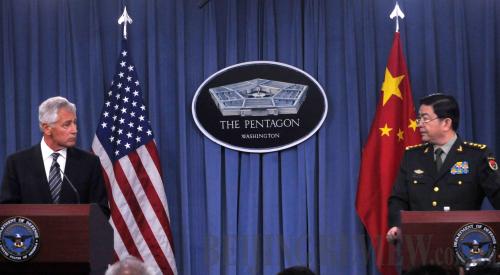|
 |
|
STRENGTHENING TIES: Chinese State Councilor and Defense Minister Chang Wanquan (right) meets the press together with his U.S. counterpart Chuck Hagel in the Pentagon during his visit to Washington D.C. on August 19 (CNSPHOTO) |
On August 28, the second ASEAN Defense Ministers' Meeting-Plus (ADMM-Plus) kicked off in Bandar Seri Begawan, Brunei. In attendance were defense ministers and senior defense officials from the 10-member ASEAN bloc, along with their eight Asia-Pacific dialogue partners—namely, China, the United States, Russia, Japan, South Korea, India, Australia and New Zealand.
The event drew a flood of attention due to current complications in the regional security environment. The United States has adopted a "rebalancing" strategy in the Asia-Pacific region over the past two years. China has been involved in heated territorial disputes with Japan and several ASEAN countries. Some ASEAN countries have increasingly expressed feelings of insecurity due to the tensions, which have caused a divergence of opinions in terms of diplomatic and defense policies among them.
In addition to threats from terrorism, extremism, pirates and cross-border crimes, currently, ASEAN countries have two major security concerns. For one thing, they are concerned whether China will seek control over the South China Sea. As China strengthens, it has revealed a more progressive face in dealing with strategic and diplomatic situations in the region. In addition, the U.S. "pivot to Asia," interpreted as a move to maintain its dominance in the region, has aroused concern among ASEAN nations about the likelihood of confrontation between China and the United States, and whether they will be forced to take sides.
These worries are a reflection of a profound change in the region. ASEAN feels increasingly fragmented as a quickly rising China confronts the United States' deep-rooted interests in the region. The bloc has become a target of competition between the two powers. But while ASEAN welcomes the U.S. military presence in the region, it is not willing to become a tool of U.S. attempts to contain China. It is trying to strike a balance between the two countries and hopes all sides can achieve win-win situation.
During the ADMM-Plus meeting, China and the United States reaffirmed their political and security promises to ASEAN.
Amid the escalating conflict in Syria, the U.S. Secretary of Defense Chuck Hagel still made it to the meeting and paid visits to Malaysia, Indonesia and the Philippines. He said the United States remained committed to a strategic focus toward the Asia-Pacific despite budget pressures and Middle East distractions. This was his second journey to Southeast Asia within three months. Hagel spoke highly of the new model of military-to-military cooperation with the Philippines called "rotational presence" and declared a 50-percent increase in military education and training programs in the region. He added the United States would increase defense trade, share American military technology and expertise with Southeast Asian nations, and standardize humanitarian disaster relief operations.
At the meeting, Hagel warned his counterparts that actions at sea to advance territorial claims "increase the risk of confrontation, undermine regional stability and dim the prospects for diplomacy."
The unexpected rise of territorial disputes on the South China Sea between China and several ASEAN countries in 2010 has been cited as a result of the U.S. decision to carry out the rebalancing strategy toward the Asia-Pacific. In order to justify its return to Asia and more closely contain China, the United States has taken advantage of the relatively tense situation on the South China Sea. It has pushed for the creation of a code of conduct to avoid direct confrontation with China.
China simultaneously carried out a new round of ASEAN-related political, military and diplomatic actions in Beijing and Brunei. It reaffirmed that the new administration would give top priority to ASEAN when handling diplomatic ties with its neighboring countries. China's State Councilor and Defense Minister Chang Wanquan stated in Brunei that China is an avowed participant and contributor to Asia-Pacific security. China actively participates in the practical cooperation of the ADMM-Plus mechanism and is dedicated to enhancing joint capabilities to confront threats and challenges.
| 